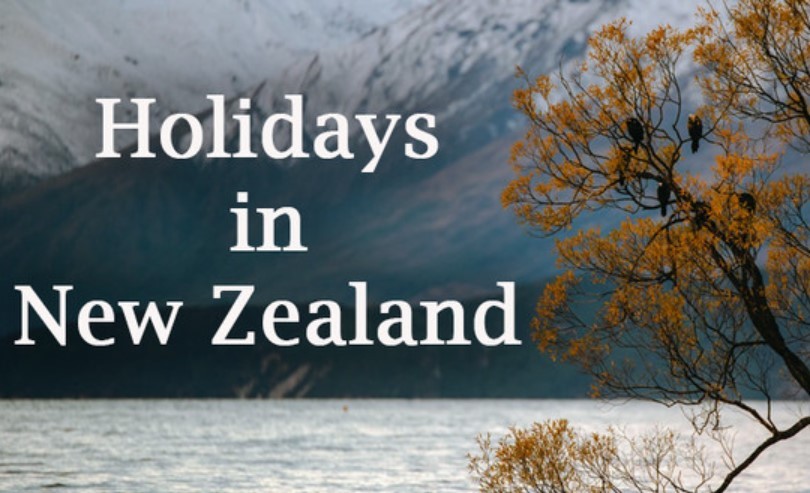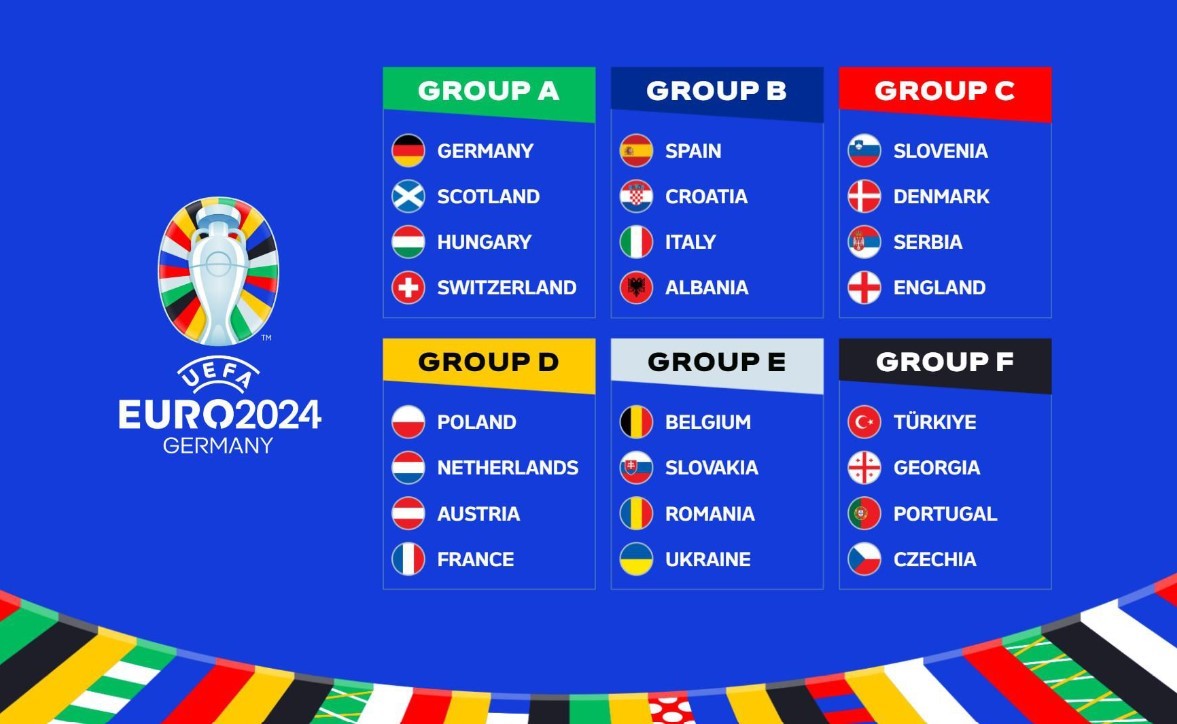What Is The Capital of New Zealand: History, Facts, Best Places to See
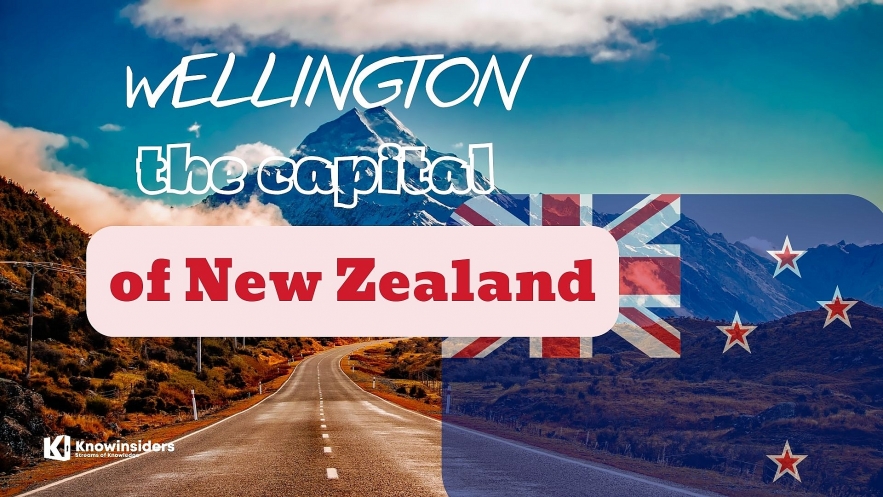 |
| What Is The Capital of New Zealand: History, Facts, Best Places to See. Photo: knowinsiders. |
What is the Capital of New Zealand?
The Wellington region takes in Wellington, Lower Hutt, Upper Hutt and Porirua cities and the Kāpiti Coast. It includes all of the territory of Greater Wellington (the Wellington regional council) except Wairarapa.
Wellington, our capital city and home of Zealandia wildlife sanctuary is culturally rich. How much do you know about New Zealand? Let’s start with the basics, including history, best places to go and frequently asked questions and facts about the capital of New Zealand.
*****
History of Wellington
According to tourism.net.nz, colonisation of Wellington began by the Europeans in 1840, when settlers arrived in the ship 'Aurora'.
Colonel William Wakefield, a New Zealand Company representative, originally planned for the Wellington settlement to be where Petone is now situated. However when the Hutt River burst its banks and flooded the area, the site was shifted to its current location.
The seat of government in New Zealand was moved from Auckland to Wellington in 1865, largely on the basis of Wellington's central geographical position.
According to David Thorns and Ben Schrader, 'City history and people - The first towns', Te Ara - the Encyclopedia of New Zealand, towns were an essential part of European colonising schemes, becoming the commercial, administrative and cultural hub of each venture. This is a view of the fledgling town of Wellington in 1842. Houses hug the beach (now Lambton Quay), which sweeps around Kumutoto Point (Woodward St) towards Thorndon Flat. William Mein Smith, the New Zealand Company surveyor, painted the image with a view to attracting further settlers. Key buildings and facilities are identified to show the town’s progress, including William Wakefield’s house, Barrett’s Hotel, the medical hall, emigration barracks and wharf. Smith also highlights Kumutoto pā, perhaps to emphasise how Māori lived among the Europeans.
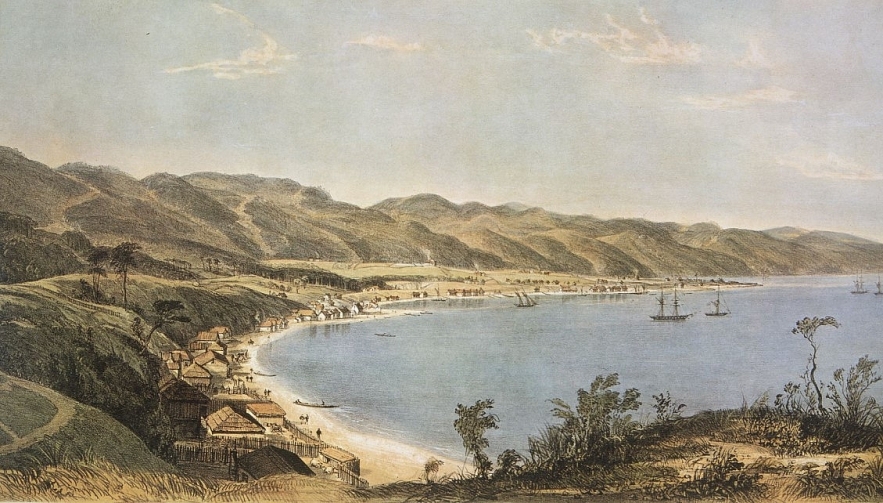 |
| Photo: teara.govt.nz. |
Earthquake alters Wellington landscape
On 23 January 1855, as wellington.govt.nz reported, Wellington was rocked by the strongest earthquake recorded in New Zealand. The 8.2 magnitude quake was centred 25 kilometres from the city - it was felt as far away as Canterbury in the South Island.
The earthquake caused widespread damage in Wellington. Timber houses collapsed, the Government Offices were levelled, and large waves pounded the Wellington shoreline.
The Wellington landscape had been altered. The coastline, in places, had risen 1.5 metres; shore platforms now encircled the harbour, creating natural routes for road and rail.
The end of the Basin Lake
A canal running from the waterfront to the Basin Lake at the end of Kent Terrace was intended for barges to deliver goods to Newtown warehouses. Wellington's miniature Venice vanished, however, when the 1855 earthquake struck.
The earthquake had raised the lake and prisoners were sent to work to turn the land into a public park. The Basin Reserve soon became the home of Wellington cricket.
Wahine Disaster - 10th April 1968
The Wahine Disaster is the most well known of the shipping disasters in New Zealand, though there have been worse disasters with greater loss of life.
The tragedy was caused by two huge storms that collided and exploded over Wellington.
The ferocity of the storm meant the capsize of the ship was inevitable, the order was therefore given to evacuate the ship. Of the 734 passengers and crew on board, 51 people lost their lives.
On shore, the storm caused even greater damage as flooding covered the shores.
The storm also marked the coming-of-age for television news broadcasting in New Zealand as camera crews rushed to report on events as they unfolded. The footage of the disaster was screened around the world turning the world's attention to Wellington.
The television coverage of the disaster later won an international World News film award.
| Wellington is the capital city and second most populous urban region of New Zealand. It is actually comprised of 4 cities: Wellington city located between Cook Strait and Wellington Harbour with about 50% of the population; Porirua on Porirua Harbour; Lower Hutt and Upper Hutt to the northeast. In 2018, Wellington has a population estimated at 418,500, growing slightly from the 397,000 estimated in 2013, as worldpopulationreview reported. The urban area has a fairly low population density of 2,300 people per square mile, or 900 per square kilometer. The larger metropolitan area has a population of about 403,000, with a density of 750 people per square mile (290/square kilometer). The urban area has 99% of the population, with the remaining areas being mostly sparse farmland and mountains. The city of Wellington covers a surface area of approximately 442 km2 (171 sq mi). The metro area expands outward to a total of 1,388 km2 (536 sq mi). |
Best Places to See in Wellington
A trip to the capital wouldn't be complete without seeing the following attractions:
Wellington Cable Car and the Kelburn Lookout
According to holidify.com, one of the top attractions of town, Wellington Cable Car is a funicular railway running between the stations of Lambton Quay downtown to the famous Wellington Botanic Garden upwards. The distance covered is a thrilling upwards climb and the car uses the cable traction for movement. Covering a distance of 612 m and rising up a steep hill of height 120 m, the trip is a wonderful transition from the chaos in the heart of the city to the beautifully terraced steps on the hills of the Botanic Gardens.
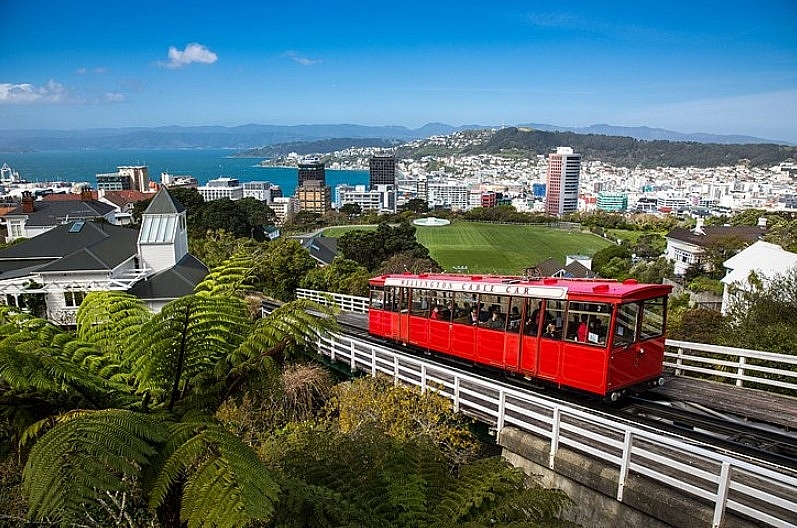 |
| Wellington Cable Car. Photo: planetware.com. |
Te Papa Tongarewa
New Zealand’s national museum, Te Papa, is a must-visit for art lovers, history buffs, and science geeks, as the culturetrip reported. Its innovative displays are renowned for being interactive and incredibly unique. Te Papa is also home to many fascinating Maori artefacts and treasures.
Explore New Zealand’s history, art collections, the natural world, and much more at the country’s national museum. A trip to Te Papa is ideal for a rainy day, or if you’re looking to learn a little something new. Consistently rated as the top tourist attraction in the city, Te Papa won’t disappoint.
Wellington Botanic Garden
No trip to Wellington would be complete without a visit to the marvellous Botanic Garden. Its bounty extends over 25ha (60 acres) of exquisite landscapes, exotic plants and native bush, and its myriad of beautiful floral displays is open for everyone to enjoy (for free) from dusk until dawn.
| Timings : Dawn to Dusk, Everyday; Treehouse Visitor Centre: Mon – Fri 9:00 AM – 4:00 PM; Begonia House Gift Shop & Cafe: Oct - March 9:00 AM - 5:00 PM, Apr - Sept 9:00 AM - 4:00 PM; Carter Observatory: Nov - Apr 10:00 AM - 5:00 PM, until 10:30 PM on Saturday and May - Oct 10:00 AM - 5:00 PM, and until 9:30 PM on Tuesday and Saturday Time Required : 1 - 2 hrs Entry Fee : No Entry Fee, Carter Observatory: Adults - NZ$18 , Kids (4 - 16 yrs) - NZ$8 |
The Beehive
Considered to be a landmark building of the town, The Beehive is the Executive Wing of the iconic New Zealand Parliamentary buildings. Situated at the corner of Molesworth Street and Lambton Quay in Wellington, New Zealand, The Beehive is called so because of its shape that is in the form of a traditional beehive, also known as a ‘skep’. The building houses the office of the prime minister and the Department of Prime Minister and Cabinet, in addition to several other offices of other government officials. The 72 metres tall building has 10 floors above the ground and four floors below. Designed by the British architect- Sir Basil Spence in 1964, the Beehive also has an array of meeting rooms, bars, lounges, pubs and TV and Radio interview rooms.
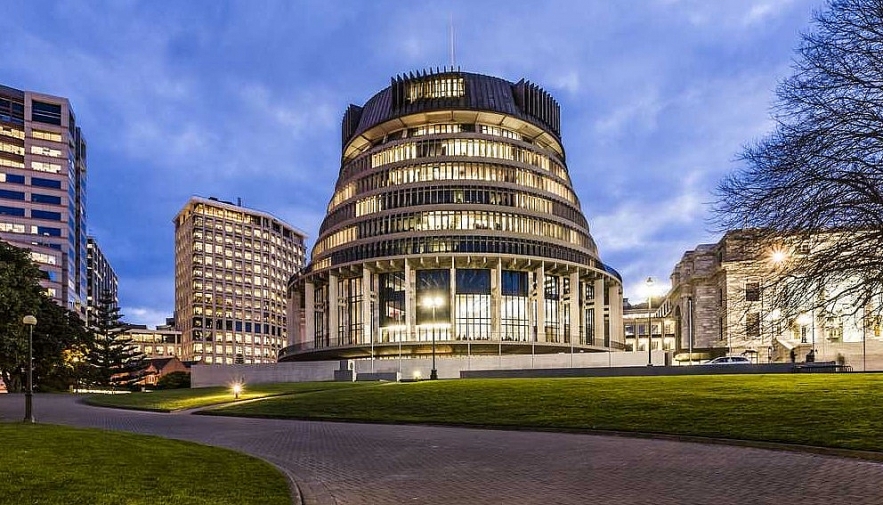 |
| Photo: holidify.com |
Zealandia
Zealandia Wildlife Reserve is an enclosed urban ecosanctuary – the very first of its kind anywhere in the world. Its mission is to protect New Zealand’s wildlife, and to return Wellington valley’s forests and freshwater systems to their pre-human state. The project has returned 18 native species of wildlife to the area, and rare birds are now thriving in this gated community.
Dedicated to exhibiting New Zealand's conservation efforts and its unique nature and wildlife, ZEALANDIA Ecosanctuary is a 225-hectare urban eco-sanctuary only two kilometers from the city center. Here, many of the country's native birds–including endangered species such as the stitchbird, saddleback, and takahe–can be heard and seen, as well as more than 100 kiwi (which can be spotted on guided night tours) and New Zealand's famed reptile, the tuatara.
Mount Victoria
According to wellingtonnz.com, the best way to get your bearings of the city is by checking out the views from the top of Mount Victoria, or Mt Vic, as the locals call it – this is part of the Southern Walkway trail. Rising 196m above the city, the Mount Victoria Lookout has stunning panoramic views of Wellington city, harbour and hills. You can drive to the top of Mt Vic or walk there via one of the many trails in the Town Belt. Mt Vic is also one of the best spots in the city for taking in a sunrise or sunset.
City Gallery Wellington, Wellington Overview
Located in the Civic Square in Wellington, City Gallery Wellington is a famous art gallery that was opened in 1980. Synonymous with the art culture of the capital city, the gallery showcases contemporary and modern art of New Zealand and also from across the world. There is no permanent display of items as the place practices changing mounts and varying exhibitions of the paintings. The gallery collaborates with different artists, creators, curators and collectors etc. to collect more and more quality products to exhibit in the exhibitions. In 2009, after a year of renovation, three more gallery spaces were added and space was extended. One of these gallery spaces was purely dedicated to Maori and Pacific Art besides a new auditorium was added. There is also a food cafe called Nikau to cater to your hunger pangs with its delicious finger food and beverages.
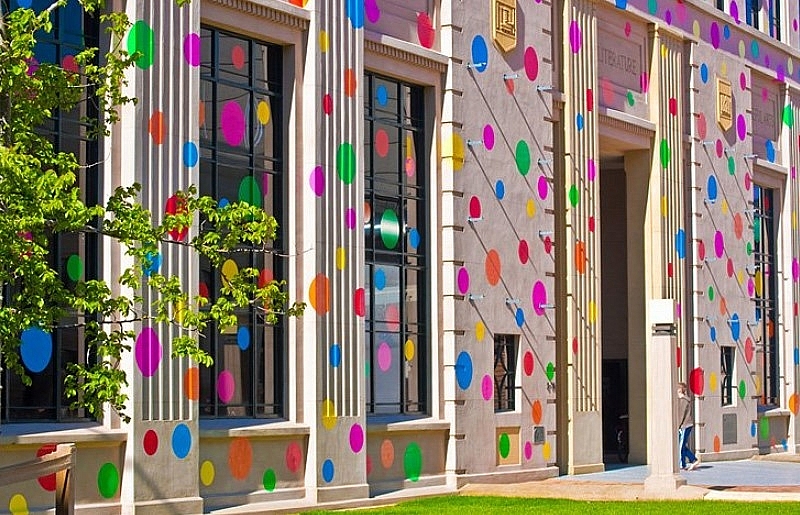 |
| City Gallery Wellington | Phillip Capper / photo modified |
Princess Bay
According to planetware.com, nine kilometers south of central Wellington, in the Houghton Bay district, is the sandy cove of Princess Bay. This sheltered sweep of sand with plenty of rock pools is a favorite swimming and picnicking spot for locals during weekends in the summer months.
On a clear day, the beach affords excellent views that can stretch across to the South Island. A short coastal track above the beach runs to a lookout point with even better views and is popular strolling territory in the late afternoon.
Address: The Esplanade, Houghton Bay, Wellington
Weta Cave and Workshop
No visit to Wellington would be complete without some Lord of the Rings trivia. Go behind the scenes and discover the movie-making magic behind the epic films at Weta Cave. Book a tour for the Weta Workshop and learn how miniature models are brought to life to create the worlds and fantastic creatures seen on the big screen.
Oriental Bay
Fancy sinking your toes into golden sand and soaking up the sunshine? Wander down to Oriental Bay for your daily dose of Vitamin D, a dip in the ocean, and that fresh sea breeze (you need to be brave in winter!). We recommend you pair your beach visit with a tasty ice-cream or some local fish and chips from nearby Mount Vic Chippery.
Interesting Facts about Wellington
Wellington is one of the world's best coffee region
According to whisperedinspirations.com, all coffee lovers will be delighted to know that Wellington has one of the greatest coffees in the world. You will see numerous coffee shops and around 20 roasteries around the city. Flight Coffee’s The Hangar, Lamason Brew Bar, and Memphis Belle are just a few of the favourite cafes in Wellington. You are sure to taste a world-class coffee when you are here.
The world’s southernmost capital
Wellington is located on the 41st latitude, making it the world’s southernmost capital (Reykjavik in our own continent, which is on the 64th latitude, is the northernmost of the world).
Wellington has the top quality of life in New Zealand
According to the Nielsen Quality of Life survey in 2014, Wellington ranked the highest in regards to overall quality of life. It was reported that 89% of the Wellingtonians has a good or better quality of life, making their city an ideal place to live in and travel to by visitors. Additionally, security is very high, which does not make anyone worry about their safety when they are in this city.
 |
| Matiu Island | Aidan / photo modified |
Named after the British war hero of the Napoleonic Wars
The city is named after the British war hero of the Napoleonic Wars (A. Wellesley, the first Duke of Wellington). Wellington led the coalition’s forces in the crucial battle of Waterloo, as countryaah.com reported.
Wellington holds three of New Zealand's most artistic festivals
First, the stirring NZ Festival, which is held every two years in the city, is a multi-arts show that brings out both local and international talents. Then, the Visa Wellington On a Plate is celebrated every August. It is a yearly culinary festival that showcases one-of-a-kind dining events, from burgers to cocktails, you will definitely enjoy this festival. And lastly, the World of WearableArt Awards Show is all about art, dance, fashion, and theatre.
There are a lot of things you need to learn about Wellington. Whenever you travel to a new place, you have to search some information about it prior to your arrival. So, if you are traveling to Wellington, you must remember the things mentioned above. These things will make you enjoy and appreciate this city.
You must keep your tongue straight in your mouth if you want to pronounce the capital’s name in Maori: Te Whanganui-a-Tara.
| Frequently Asked Questions about New Zealand When is the best time to visit New Zealand? According to tourism.net.nz, You can visit New Zealand at any time of the year. Summer and winter temperatures vary by only about 10ºC over most of the country, making New Zealand an ideal holiday destination all year round. New Zealand has four quite distinct seasons - Spring (September - November), Summer (December - February), Autumn/Fall (March - May) and Winter (June - August). In summer there's plenty of sunshine, and activities in and around the water include rafting, snorkelling, diving and kayaking. You'll find snow on the mountains in winter and excellent skiing. Away from the mountains, New Zealand winters are mild and temperatures generally do not fall below freezing. What's the climate like? New Zealand's seasons are the reverse of the Northern Hemisphere. This means that the warmest months are December, January and February, while the coldest are in June, July and August. Don't let cold months put you off - winters tend to be short and generally fairly mild. What is the water temperature? The water temperature of the sea surrounding New Zealand varies between seasons, and is warmer the further north you go. In winter, the ocean temperature surrounding the lower South Island drops as low as 8°C, whilst around the upper North Island water temperatures average around 15°C. In summer the sea temperature around the South Island varies from around 14°C to 18°C. The North Island water temperatures are lovely and warm at around 20-22°C. What clothes should I take? Dress is informal and relaxed on most occasions. Smart casual clothes are acceptable at most restaurants and night-spots. Men are generally not expected to wear suits and ties, except in a few of the top formal bars and restaurants in major cities. In summer a light jacket or sweater should be included in your luggage should the weather turn cooler or you visit the high country. You can expect some rain, so include a light waterproof jacket or coat. Pack warm winter clothing if visiting between May and September. Layer your clothing. |
 What Is The Capital of Italy: History, Facts, Best Places to See What Is The Capital of Italy: History, Facts, Best Places to See With the unification of Italy, Rome was chosen capital of the country in 1870. Nowadays, it is one of the most visited cities in the ... |
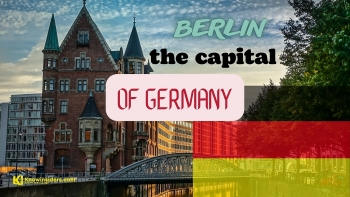 What Is the Capital of Germany: History, Facts, Best Places to See What Is the Capital of Germany: History, Facts, Best Places to See Berlin, the capital of Germany and the country's largest city, is also a major center of politics, culture, media, and science. We rounded up all ... |
 What Is the Capital of France: History, Facts, Best Places to See What Is the Capital of France: History, Facts, Best Places to See We rounded up all things you need to know about France's capital - Paris. Paris is undeniably one of the most beautiful cities in the ... |


